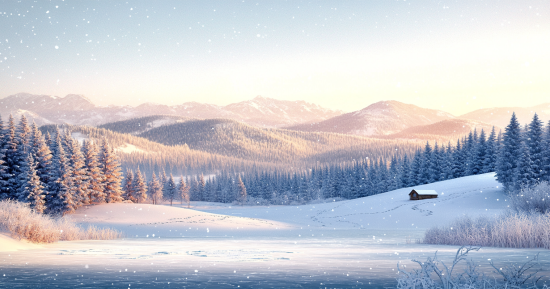Winter brings a unique opportunity to explore the serene beauty of snow-covered landscapes through art. The charm of winter scenes can be captured stunningly in a horizontal format, offering a panoramic view that feels expansive and inviting. A winter landscape horizontal painting adds warmth and a sense of calm to your home decor, making it an ideal choice for the season. Whether you’re an aspiring artist or simply someone who loves the beauty of a snowy scene, a horizontal canvas can present a whole new perspective on winter’s wonders.
Winter Painting Horizontal
Incorporating snow-covered pine trees, gently falling snowflakes, and tranquil rivers can create a magical winter wonderland in your living room. Whether you decorate your wall with your creation or a handmade piece from a talented artist, the beauty of winter landscapes can genuinely enhance your living space.
Exploring the Allure of Winter Landscapes

Capturing Snowy Scenes
When you think about winter landscapes, the image of snow-covered fields and forests likely comes to mind. These scenes offer a canvas painted in white, grey, and blue shades. Snow transforms ordinary surroundings into something magical. To capture this, you can play with the light and shadows that snow creates, adding depth to your painting.
Incorporate the texture of snow by experimenting with techniques to show its sparkle and softness. Look how Sir Arthur Streeton used large shapes and finer details to create stunning snowy scenes. This balance makes the landscapes feel both vast and intimate. By focusing on these aspects, you can bring the serene beauty of winter to your artwork.
The Charm of Winter Wildlife
Winter landscapes aren’t just about snow. The wildlife, like deer walking through the woods or birds huddled on bare branches, adds life to these scenes. These animals are not only part of the scenery but are also symbols of survival and resilience. Observing them can add warmth and movement to your paintings.
It’s interesting to note how the environment influences wildlife behavior. You might see how animals gather food or find shelter, which tells a story in your art. This story-telling aspect can draw viewers in, letting them feel the quiet beauty of nature during the colder months.
Depicting the Winter Sky Moods
The winter sky can range from bright and clear to overcast and grey, each offering a different mood to your painting. The reflection of light on the snow can create remarkable hues, from warm pinks at sunset to icy blues at noon. This variety allows for creative expression.
Skies have a strong influence on the tone of a landscape painting. You can look at famous works, such as Pieter Bruegel the Elder’s paintings, that use the sky to enhance the winter atmosphere. Distinguishing between different times of day or weather conditions like snowfall can help set the scene, making the viewer feel like they are part of the moment.
Techniques in Horizontal Winter Paintings

Choosing the Right Palette
Selecting the right color palette is key to capturing a winter painting’s mood. Winter scenes often feature muted tones like grays, blues, and whites. These colors help depict the calm and serene feel of winter.
To add depth, consider using soft shades like lavender or pale pink. These can highlight snowdrifts and icy surfaces. Doing this creates a contrast that makes your painting more dynamic and engaging.
Experiment with mixing different hues to find combinations that evoke the chill of winter. Subtle variations can bring your painting to life, making viewers almost feel the cold air. Remember, the colors you choose help tell the story of your winter scene.
The Role of Light and Shadow
Light and shadow play important roles in your winter scene. They add depth and realism to your artwork. In winter, light is often softer due to cloudy skies, creating diffuse shadows.
Use gradations to depict this softness. For example, light glancing off snow creates gentle highlights. Shadows can be rendered using cool tones such as blues or purples. These colors contrast nicely with the brighter areas.
Carefully place shadows in your composition to enhance the texture and structure of the landscape. This will give the appearance of snow-laden branches or undulating hills. Attention to light and shadow helps convey winter’s tranquil yet stark nature.
Frequently Asked Questions – Winter Painting Horizontal
What are some easy winter landscape painting ideas for beginners?
Try creating simple scenes like snow-covered trees, icy streams, or cozy cabins when starting with winter landscapes. Focus on basic elements and shapes to capture the essence of winter. These scenes offer the chance to practice texture and shading, setting a solid foundation for your painting journey.
Which colors are best suited for capturing a winter landscape on canvas?
Use cool colors like blues, purples, and whites to paint a winter landscape effectively. These colors help mimic the cold, crisp look of winter scenery. Adding hints of warm tones like browns or reds can highlight elements like tree trunks or setting suns, bringing balance to your composition.
Can you recommend techniques for painting winter scenes on horizontal canvases?
For horizontal canvases, use techniques like layering to add depth. Building layers of lighter colors over darker ones can create an impression of snow. Blending is crucial to achieve smooth transitions between sky and earth. Try using a fan brush to create texture in snow and trees.






